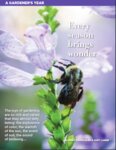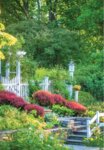The joys of gardening are so rich and varied that they almost defy listing.
This item is available in full to subscribers.
We have recently launched a new and improved website. To continue reading, you will need to either log into your subscriber account, or purchase a new subscription.
If you are a digital subscriber with an active subscription, then you already have an account here. Just reset your password if you've not yet logged in to your account on this new site.
If you are a current print subscriber, you can set up a free website account by clicking here.
Otherwise, click here to view your options for subscribing.
Please log in to continue |




The joys of gardening are so rich and varied that they almost defy listing: the explosions of color, the warmth of the sun, the scent of soil, the sound of birdsong. Research has linked gardening with reduced stress and improved mental health, benefits that aren’t limited to people with access to spacious yards. We’ve gardened on tiny urban plots, fire escapes and windowsills. The only thing a successful gardener needs is commitment.
So what keeps people from starting or restarting a garden? One of the biggest challenges for novice and intermediate gardeners alike is uncertainty about timing. Like many living systems, an outdoor garden is governed by the rhythms of the seasons, and understanding what needs to be done at what time of year requires some experience.
To help you get started, we’ve created a rough guide to a gardener’s year, highlighting some of the essential pleasures and tasks of each season. Your tasks and their timing will vary according to your garden’s size and location and the specific plants you choose to grow. When in doubt, follow the directions on the plants’ labels as closely as a good cook follows recipes.
Spring
Spring is a time of hope and renewal for gardeners. We’re hungry to be outside after the long, dark winter, and our reward is glorious: the arrival of early bloomers such as camellia and witch hazel; the chartreuse of new leaf growth; the emergence of daffodils and tulips; the flowering of rhododendrons, azaleas, and dogwoods; and in late spring, the romance of peonies.
Once the ground thaws, it’s time to plant perennial flowers, evergreen shrubs, trees and roses. Annual flowers should wait until after Mother’s Day.
For gardeners, spring is also a time of clean up, preparation and maintenance. There’s plenty of work to be done, but you’ll start earning the payoff in the summer.
After clearing out and pruning back debris, dead plants and weeds from your garden beds, add compost and gently turn it into soil, then mulch your beds to retain moisture and suppress weeds. You can sprinkle pre-emergent herbicide prior to mulching to prevent weeds from sprouting. Also on the to-do list: raking your lawn to level out worm castings (the plant-friendly product of earthworm digestion), winter debris and thatch; pruning back late-flowering shrubs (e.g. Buddleia, Russian sage, roses and shrubs with colored stems); fertilizing newly planted trees and shrubs according to their instructed care (we recommend tree spikes for evergreens); and staking the perennials that will need support as they grow, such as peonies.
Summer
Color is one of the great pleasures of gardening, and summer is when we see the full, riotous spectrum in our gardens, from deep purples to bold oranges. For many of us, the ultimate summer celebration of color is harvesting our hydrangeas, an iconic garden plant in our region. The taste of the season is tomatoes, a late summer treat.
Summer’s themes are watering and fertilizing. Your garden should be watered regularly throughout the season, especially during hot and dry periods. In case of long dry spells, be sure to water at least once every 10 days. Water your plants at the roots, not on the flowers or leaves. Apply fertilizer and/or compost to vegetable and flower beds according to their specific needs.
As your flowering plants blossom, remove dead or faded flower buds and seed heads (a process called “deadheading”) to promote new growth and encourage more blooms. Prune and shape shrubs immediately after flowering. Do you have roses? They should be deadheaded as they flower, and suckers — the rogue branches that grow from the rootstock rather than the part of the plant that flowers — should be removed. Mid-season fertilizing of your roses will encourage continued flowering.
Weeds are the curse of summer for gardeners. Weed your garden regularly to prevent weeds from competing with your plants for water and nutrients.
Fall
Fall gardening means cooler air, meadows of flowers, shimmering ornamental grasses and, most of all, a new palette of colors, from the autumn hues of changing leaves to the cheerful starbursts of purple asters.
It’s a good time to plant spring-flowering bulbs such as tulips and daffodils. Planting trees and shrubs in the fall allows them to establish root systems before going dormant. Don’t add fertilizer beyond what’s in your planting soil; you don’t want the newly planted shrubs to think it’s time to start growing.
Fall is also a time to clean. Remove spent annuals and vegetables from garden beds. Gather up fallen rose leaves as they drop (dispose of those with Black Spot) and cut back long rose canes that may break over the winter. Dig up and store tuberous bulbs such as dahlias, elephant ears, and cannas before frost. It’s a good time for hard hedge trimming, too.
Winter is coming, and preparations must be made. Mulch your garden beds or apply evergreen branches to protect plants from freezing temperatures. In unmanicured areas, consider leaving fallen leaves as a natural mulch. Elsewhere, consider raking fallen leaves to use as compost for the winter. Leaves are a resource not to be wasted, but remember that gardens and lawns don’t like leaf cover.
Winter
Even in the dead of winter, your garden can be a source of surprising beauty. The bark on many common garden trees and shrubs — crepe myrtles, Stewartia, paperbark maple and oakleaf hydrangea, to name a few — is gorgeous. We love snowdrops, winter-blooming bulbs that earn their name because of their small white blossoms and the way they emerge from the snow and ice, foreshadowing what’s soon to come in the spring.
Winter is a time when gardeners make plans. They think about next year’s garden layout, research new plants and techniques, select seeds, and order supplies. They clean and store their tools and sharpen their hedge clippers, pruning shears, and shovels for next season.
There’s plenty of gardening and preparation to be done indoors. Start seeds indoors for early spring crops. Check stored bulbs, tubers and rhizomes for rot or drying out. Keep an eye on any plants overwintering indoors for pests and diseases.
Perhaps most of all, make some time for the birds in the winter. Clean out or place birdhouses for winter roosting and early spring nesting.
Emily Daeschler is president of the Board of Directors of the Chestnut Hill Garden District Fund, a nonprofit organization dedicated to beautifying Chestnut Hill, a Philadelphia community famous for its flowers, gardens and parks. Judy Larini is the Chestnut Hill Garden District Fund’s streetscape gardener and founder of Flower Powered, a Philadelphia-based landscape design, build and maintenance firm.